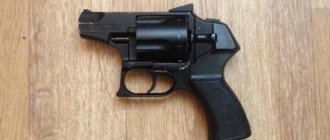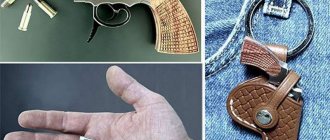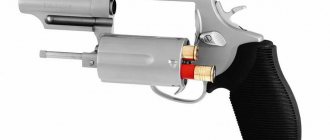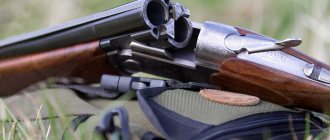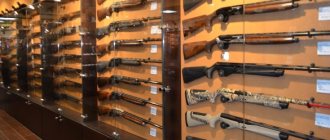The exact date of creation of a firearm called a pistol is unknown. Place of creation too. If you believe modern researchers, the word “pistol” has French roots, and according to other sources, it has Slavic roots. “Pishchal” is nothing more than a pipe. It was metal tubes that were used to make the first small arms.
Danila climbed with a backpack into the attic of an abandoned house in Manhattan. There was desolation all around, which is so necessary today. He pulled out a piece of wood he had picked up on the street, a coil of wire and a copper pipe. Using a knife, I made a primitive stock, fitted the tube and tied it tightly with wire. He clamped the back end tightly, making a small hole in it. Then he filled the tube with a mixture of saltpeter, manganese and sulfur, and sprinkled scraps of nails on top. The "pistol" was ready!
Many people remember the scene from the movie “Brother-2,” but not everyone knows that the first real pistol had a similar origin story.
Things from days gone by
Miniature copies of muskets became widespread in the 15th century AD. According to available information, the trendsetters were Italians (from the city of Pistoia, which is an additional argument), but this is only one of the versions.
Most likely, they simply put production on stream. But, in any case, soon the brilliant French nobles began to actively shoot their rivals in the boudoir of Parisian beauties.
D'Artagnan's ancestors borrowed this innovation from German mercenaries captured by the troops of Henry II in the battle with Italian troops at Ranti in 1554.
At that time, the weapon was equipped with a wick fuse (or lock), and although it was more comfortable to carry, it did not load much faster.
https://www.youtube.com/watch?v=pV0CalRL-Z4&t=13s
Most often, pistols were used by cavalrymen; holsters with loaded pistols were hung from the saddle.
Type 26
This weapon is also known as the Hino revolver. It was developed in Japan in 1893 and was also adopted by the Imperial Japanese Army. This model got its name due to the special chronology that is still used in its homeland.
Initially, it was decided to adopt this revolver for cavalry use. In this case, a safety cord was used, attached to a ring on the handle. It is a breakaway style pistol and was somewhat similar to the early Smith & Wesson models. The trigger worked without a spoke. The weapon used 9×22 mm R cartridges.
Next step
In the 16th century, the inconvenient and dangerous wick was replaced by a wheel mechanism (according to legend, Leonardo Da Vinci himself had a hand in creating such mechanisms). The structure was started using a key.
This made it possible to avoid misfires, but complicated the loading process. Despite the simplification of the design over time, wheel locks remained extremely complex and expensive to manufacture, therefore, despite their reliability, they gradually gave way to other methods of ignition.
It is worth noting that some of the pistols already at that time acquired the semblance of unitary cartridges; it was not the pistols themselves that were charged, but separately inserted charging chambers; to reload such a pistol, you only had to change the chamber and cock the mechanism with a key.
In the 17th century, the wheeled mechanism was replaced by a flintlock mechanism, the essence of which was the hammer hitting the flint in the lock.
The carved spark ignited the gunpowder fuse in the breech (to be fair, such a mechanism was originally tested on guns). The pistols were, naturally, smoothbore. Although there were also rifled ones, in this case they were made by masters, and therefore extremely rare.
Already at the beginning of the 19th century, a capsule, a cap with a flammable composition, appeared. In view of this, the flintlock mechanism left the scene, since ignition using a primer was more convenient and faster. Initially smooth-bore, with the development of industry, pistols also received rifled barrels, which made it possible to improve the accuracy of the battle and increase the effective firing range.
Since the mid-twentieth century, weapons - pistols and revolvers - have taken another step towards increasing the rate of fire and multiple charges.
Colt Single Action Army
This particular model of a revolver from the late 19th century was developed specifically at the request of the US government, and after a series of tests it was adopted by the army. The weapon is a six-shot, single-action weapon.
The revolver turned out to be popular due to the fact that it was simple, but at the same time powerful and heavy. This weapon turned out to be prefabricated, since it was made according to several Colt drawings. This is probably why the design and construction of the handle, partly the appearance of the trigger and the trigger mechanism have been preserved. To all this was added a monolithic closed frame and the use of special cartridges.
You may be interested in: Creation of a nuclear missile shield in the USSR
Pistols and revolvers
The desire for speed of fire led to the creation of the revolver. The first samples were created back in the 16th century. The essence of the invention was the use of a rotating (translation of the word revolver) drum with charges.
But, in the presence of a flintlock, it was cumbersome and had the same problem with the constant addition of gunpowder to a special shelf to ignite the main charge and did not provide continuous firing.
The time of revolvers came in the 19th century.
At the beginning of the century, officer Artemas Wheeler from the United States officially documents the invention of a pistol with a cylinder and a percussion flintlock. A little later, the Englishman Collier presented an improved model in London.
The presence of a powerful spring in the form of a plate (a prototype of a mainspring) pushed the drum tightly and prevented breakthroughs of powder gases. A gun with a similar reloading mechanism was also presented.
This weapon was interesting, but too expensive and did not become widespread in Europe.
However, the design features were taken into account by gun specialists.
With the invention of the capsule, which ensures relatively continuous firing and machine-tool production of weapon components, which significantly simplifies and reduces the cost of work.
In 1836, a certain Mr. Pearson sold the invention of a pistol with a revolving mechanism for feeding cartridges to Colonel S. Colt in the same USA. Samuel established the mass production of capsule revolvers, known today as the Colt “Peacemaker,” and will forever remain in the memory of grateful humanity.
Soon American revolvers replaced similar single-shot types of weapons throughout the world. In the modern United States, there is a proverb about this: “God created people as they are, and only Colonel Colt made them equal.”
Nagant M1886
Another revolver from the late 19th century, which was created for the Russian Empire. The weapon had seven charges, and was developed by the brothers Emil and Leon Nagant. The 1886 model received reduced weight, a reliable and technological design. For example, it was decided to replace four springs with one double spring. It was decided to go in the direction of reducing the caliber, so the revolver received 7.5 mm.
This 19th century revolver gained particular popularity in Russia. It began to be used actively in 1900. By 1914, almost 500 thousand copies were put into service. It is also believed that the Nagan became one of the symbols of the Russian Revolution. Because of the events of 1917, other models and even self-loading pistols were often named after this revolver.
Self-loading competitors
The hegemony of revolvers was interrupted by the invention of a semi-automatic type of reloading. In a weapon using innovation, the cartridge was fed from a box magazine into the breech through the use of powder gases, rather than the physical rotation of the drum.
The first sample appeared in 1892 in Austria-Hungary, manufactured by the Steyer arms factory. Subsequently it entered service with the cavalry units of the Austro-Hungarian army.
Subsequently, self-loading pistols took their perhaps main place in the history of small arms. And now about the differences in designs.
Lefaucheux M1858
This weapon became known in France thanks to Casimir Lefauchet. The first version of the designer worked with a hairpin chuck. After this, in 1853, the revolver was adopted into service in the country. This event marked the beginning of the use of this type of weapon in the army.
The 1858 version is equipped with an octagonal barrel with a front sight. The drum received protrusions. When the cartridge comes in line with the barrel, the cylinder is locked. The hammer can be cocked manually. The spring protects the rod from accidentally falling into the drum.
By the way, Lefoshe revolvers were also used by the army of the Russian Empire. The Officer Shooting School liked them and were considered comfortable and simple.
Similarities and differences
Both types of weapons have a frame with a barrel, but unlike a revolver, a self-loading pistol may have an unsecured (free) barrel. The frame has a built-in housing with a trigger mechanism. Revolvers do not have a bolt with a spring and other components (ejector, bolt, etc.). Accordingly, an absolutely excellent cartridge feeding mechanism.
For revolvers, cartridges are located in chambers (special compartments) of the drum, and for self-loading (automatic) pistols, in magazines. The location of the magazine can be different, both in the handle and in a separate part of the weapon. The supply of ammunition is carried out by powder gases.
Clumsy and reliable. What does the Borchardt have in common with the Mauser and Parabellum?
The second model embodied in metal and the first truly successful automatic pistol is considered to be the sample of the German Hugo Borchardt Borchardt C93 (“Borchardt” K93). Its automation used a short barrel stroke; the bolt was locked using a system of levers, which, when the bolt was locked, were in the so-called dead center position. A detachable box magazine for 8 rounds of 7.65x25 mm was located in the handle.
Why “legendary” pistols of the 20th century are often overrated
The design turned out to be very reliable and immediately received a number of rave reviews. The pistol was patented in ten countries, including England, Germany, France, and the USA. True, no one was in a hurry to take it into service: due to the protruding butt plate of the frame, the weapon was huge and awkward. With a barrel length of about 19 cm, the Borchardt K93 had a total length of more than 35 cm. But it was a success in civilian life - among hunters and travelers. Moreover, the weapon was equipped with an attached butt and could be used as a light carbine. Three years later, the concept of a pistol-carbine would be used by the creators of the famous Mauser K96.
And Borchardt's pistol very soon fell into the hands of the Austrian gunsmith Georg Luger. He modified the design (in particular, by simplifying the locking mechanism, thanks to which the protruding “heel” disappeared), increased the tilt of the handle, and as a result, in 1898, an extremely successful, compact and elegant pistol appeared, which in Russia became known under the commercial name “Parabellum” .
Cartridge
Revolving cartridges are distinguished by the presence of a rim, and, as a rule, by increased power, since placement in the chambers of a drum, without the presence of moving parts, limits the strength of the designer less. But now these lines are blurring, revolvers can be designed for a pistol cartridge, but in this case the cylinder requires more complexity to securely fix the cartridge in the chamber.
Pistol cartridges may differ in design, such as a hidden flange or a semi-protruding one, the fact is that flangeless cartridges are more suitable for use in box magazines. But at the same time, unlike revolver cartridges, the power of a pistol cartridge cannot be increased unnecessarily; this will lead to rapid wear of the rubbing parts of the pistol.
The most famous pistol cartridges are used - the iconic US pistol - Colt M1911, 11.43 mm cartridge, M9 pistol, 9 mm Para Luger cartridge, 9x18 mm PM cartridge.
Galand
Another Belgian revolver, which was released in 1868 under a patent. Interestingly, they worked on it for the Russian Navy. The drum could hold up to six 12mm cartridges.
The peculiarity of the revolver was its unusual and capricious design. During reloading, part of the frame, drum and barrel were partially pushed forward. Weapons were manufactured for special cartridges, which replaced pin-type ammunition. There were military samples with a caliber of 12 mm, and there were commercial ones - 7 and 9 mm.
Galan worked a lot on revolvers. Therefore, over the course of four years, several types of weapons were released. The first was a pistol of the 1868-1872 model, followed by a pocket model with reduced dimensions. There was also a “Baby” revolver, which turned out to be even smaller than the previous one.
Details
The biggest difference is the cartridge feeding mechanism. Revolvers are equipped with drums containing compartments for ammunition - chambers (it is not for nothing that the word revolver comes from the Latin revolvere - to rotate). On the first samples, the drum was driven manually (there are models of multi-barrel revolvers, where each chamber is a separate barrel).
With the invention of the leaf spring, rotation was ensured by it when transmitting muscular force when pressing the trigger. The installation of the drum can be either fixed, on an axis in the frame, in this case, a device called an Abadi door is used for reloading, or the fracture structure of the frame itself, in this case, reloading is carried out when the body of the weapon is broken.
The drum can also be tilted to the side, or even removed from the frame. A trigger revolver can be either double or single action. In the first case, the shot is fired only by pressing the trigger; single-action revolvers require preliminary cocking of the hammer. This mechanism was used in the Colt “Peacemaker”, for example, or in the soldier’s Nagan mod. 1898.
Semi-automatic and automatic pistols use the energy of powder gases and recoil to reload.
The pistol is fed with ammunition from a magazine, which can be of any design; they are united only by the method of feeding the cartridge, one at a time and alternately.
Pistols, unlike revolvers, have a wide range of varieties and types. Mainly related to store placement and design:
- Box-shaped, integral - Mauser C96 or Steyr 1912;
- Box-shaped, detachable in the handle - classic - Browning, Colt M1911, TT;
- Disk, increased volume – Borchard-Luger R.08;
At the same time, there are also extremely interesting weapons, for example the Mannlicher pistol mod. 1884, which has a single action trigger.
Tubular Volcanic. Reload with one left
Until the end of the century before last, the revolver unconditionally dominated the world of short-barreled weapons. From time to time, designers tried to create versions of multi-shot non-automatic pistols, where reloading would be carried out using the muscular strength of the shooter. But it was like reinventing the wheel - each time non-viable monsters were born who were obviously inferior to the revolver in all respects.
One of the most successful attempts to come up with an alternative to the proven rotating drum system was the American Volcanic pistol from Smith & Wesson, introduced in 1854. It used an under-barrel tubular magazine and an original caseless ammunition that housed the powder and primer inside a hollow, conical bullet. The Volcanic was reloaded by moving the trigger guard, equipped with a special ring for the finger. This is very similar to reloading Winchester rifles with a Henry brace. The only difference is that when shooting from a rifle, working with the brace is easy and convenient - you hold the weapon with both hands and can reload without removing it from your shoulder. With a pistol, everything turned out to be much more complicated - it was very difficult to reload it with one hand, but to constantly operate with both hands... it would be easier to take a full-fledged rifle then.
Classics of the genre
The description and characteristics of various types of pistols and revolvers deserve not just an article, but a multi-volume publication. Let's look at the most famous and well-known ones. The hit parade of famous models opens:
Lepages are French flintlock pistols designed by Jean Le Page, produced in sets. Due to the all-Russian fame of the novel by A.S. Pushkin "Eugene Onegin". The poet’s fatal duel, interestingly, took place on Karl Ulrich’s percussion pistols.
Colt is a surname that has become a common noun for most revolvers. American pistols are an integral attribute of police weapons in many countries; the most famous is a pistol designed by Browning, but produced by the Colt factory - M1911 .45 caliber.
Other famous US revolvers and pistols:
- Smith-Wesson arr. 1871 (an American revolver that was in service with the Russian army, which is why it received the designation “Russian”);
- Colt M1911 - it is this pistol (more precisely, its designer Joseph Moses Browning) that history owes to the main design features of self-loading pistols.
Nagan is a similar, but European story. Patented by the Belgian gunsmiths - the Nagan brothers, the revolver entered service with some armies, thanks to one interesting new product. Nagans solved the problem of the breakthrough of powder gases between the barrel and the cylinder of a revolver. Before firing, the drum moved towards the barrel, and the muzzle of the cartridge case entered its channel.
German pistols are a whole galaxy in the small arms universe. The first number was the Mauser S-96, mentioned above. But the most popular were the German pistols of the Second World War of the Walter and Luger brands. Of course, these are also the names of the designers.
But what’s interesting is that the Prabellum, which has become a symbol of the German army, is one of the Luger models. The modification for artillery units with a long barrel looks especially impressive.
Walter is better known as a James Bond weapon (PPK model), but in the modern world it is in demand both in the army and police forces.
You can also talk for a long time about USSR pistols. The first example of combat pistols from the Country of the Soviets was the famous TT (a project by designer F.V. Tokarev), created in 1929 in order to replace models of foreign weapons.
Other classic models are the Makarov pistol (PM) and the Stechkin automatic pistol (APS), which are in service with the army and law enforcement units.
Currently, a number of bright and talented designers have emerged - Yarygin with his PYa ("Rook"), for example, in addition, pistols created by teams of authors have appeared - GSh-18 and others.
Weaponry schools in Switzerland, Austria and Italy are also known. Beretta, ZiG and Glock pistols occupy the top ranking of modern weapons.
Revolvers have given way to pistols in the military, but they are still widespread in the civilian market and among the police. Moreover, the French special forces use revolvers as additional weapons, this is due to their high power and the fact that in the event of a misfire, the revolver does not require manipulation by jerking the bolt.
For your pocket. History of compact pistols
The end of the 19th century and especially the first decade of the 20th century were the heyday of miniature vest-pocket weapons. In that era, liberal gun laws contributed to the fact that it was considered good manners to carry a pistol or revolver in your pocket. Double-barrel derringers were also popular. A compact, lightweight and easy-to-maintain weapon, suitable for short-range defense purposes, found its design embodiment in the Remington double-barreled derringer, patented on December 12, 1865 by Remington's gunsmith Elliott and produced from 1866 to 1935 in quantities of approximately 150,000 copies.
Bond Arms' easy-to-handle Cowboy Defender features the classic style of a double-barreled derringer.
Equipped with a block of two barrels located one above the other, the Remington derringer was made in the then fashionable .41 RF short caliber. Gamblers, single ladies, secret agents and business people primarily preferred the Remington 1866 model. Early pocket revolvers were designed to produce a weapon of minimal dimensions, chambered in various .32 caliber cartridges, especially the .32 S&W long, which is still used today in sports pistols. Those who wanted to have a larger and more powerful weapon chose the .38 caliber, and the .38 Special has not lost its leading position to this day.
Introduced in 1927, the Colt Detective Special was chambered in .38 Special and became the standard for many subsequent pocket revolvers.
Small and flat was the motto of the first pocket pistols. Unlike our time, they used 6.35 mm Browning and 7.65 mm Browning cartridges. The most famous representative among these babies was, without a doubt, the FN Baby in 6.35 mm Browning caliber.
The FN 1906 in 6.35mm confirmed the reputation of the first FN vest pistols and became the predecessor of the later legendary FN Baby
As comfortable as the 6.35 mm Browning caliber babies were, their stopping power was just as catastrophic. Even with the 7.65 mm Browning, objectively speaking, one could consider oneself unarmed. In the 1970s, the German police realized this and retired Walther PPK 7.65 mm Browning pistols.
The Colt 380 Goverment is one of the few pocket pistols with a locked action. It is chambered for 9 mm kurz
For self-loading pistols, from the point of view of sufficient stopping power with the most compact dimensions of a weapon, the standard today is the 9x19 cartridge. If necessary, you can choose a step lower in power, 9x17 (.380 Auto). And if we take into account the noticeable reduction in magazine capacity, then the choice is also limited to .357 SIG, .40 S&W cartridges, as well as the old, well-deserved .45 ACP. For revolvers, everything that is said about 7.65 mm Browning in relation to self-defense effectiveness is completely true for .32 caliber cartridges. So in revolvers, as you can see, .38 Special and .357 Magnum are used, and increasingly 9x19. Revolver cartridges in .41, .44 and .45 caliber are too large to create a truly compact revolver.
From the point of view of weapon compactness and stopping power, the first choice falls on these calibers: 9 mm kurz, 9 mm Luger, .38 Special and .357 Magnum
Pistol cartridges used to be loaded primarily with jacketed bullets. Half-jacketed bullets and lead bullets were rare. For revolvers, the emphasis was on lead bullets and partial jacket bullet design. The most famous such attempts were made by the creator of the .44 Magnum cartridge, Elmer Keith. Typical examples of modern hollow-head solutions include Hornady's JHP-XTP, Speer's God Dot, and Remington's Golden Saber.
Colt Cobra (first generation here) with a rather rare 3-inch barrel has an aluminum frame
In the first years after the advent of self-loading pistols, pocket pistols were overwhelmingly equipped with a tight, single-action trigger, and long before the German police department developed technical requirements for service pistols, Carl Walther made a giant leap forward with its PP and PPK models. With the PP, Walther pioneered the use of a fully practical double-action firing mechanism. The revolutionary feature of the RR model was the double/single action trigger mechanism combined with an external trigger and a safety lever that acts as a safe release lever. To this should be added a safety device against firing when the weapon is dropped and an indicator of the presence of a cartridge in the chamber. The result is a pistol design that ensures completely safe carrying of the pistol with the hammer pulled and a cartridge in the chamber, which, once removed, thanks to the self-cocking trigger mechanism, ensures instant readiness to open fire.
In 1931 the PP model was followed by the PPK (Polizei-Pistole Kriminal) model. The basic design was retained, but the barrel, bolt and grip height were shortened. Until 1945, the total number of PPs issued was about 550,000 copies, and PPK - about 520,000 copies. A new generation of self-defense pistols, perfected in terms of safety and ease of use, arose as a kind of by-product. All over the world, since the 1980s, new service pistols have been developed and adopted by the army and police, created taking into account the relevant tactical and technical requirements. It soon became possible to design sub/compact alternatives for concealed carry based on these designs at low cost. One of the pioneers here is Gaston Glock. The reason was the competition announced in 1981 by the Austrian army for a new army pistol, intended to replace the Walther P 38 pistol from World War II. The Austrian Ministry of Defense compiled a list of 17 criteria that the new generation of service weapons had to meet. In particular, the requirements included the use of a 9 mm Luger cartridge, as well as disassembly into main parts without the use of tools.
In the Model 43, Glock used a single-stack Single Stack magazine chambered for the 9 mm Luger cartridge. It has exceptionally small transverse dimensions
What Glock proposed remains an example to follow to this day and has made Glock a world leader in this area of the market, making the US police one of its main clients. For concealed carry, Glock models, which usually have a double-stack magazine, are equipped with a single-stack magazine, which, combined with a shortened barrel, makes it possible to classify it as a compact pistol for self-defense, such as the Model 43 in 9 mm Luger caliber. Those who do not like the semi-cocked striker mechanism can find many models of self-defense weapons with a trigger and various options for the firing mechanism. The safety trigger lever in various variations has become familiar. Among frame designs, there is a trend towards the use of polymer frames with steel liners.
The Heckler & Koch P30 Subkomact is a service pistol with a polymer grip and a double-stack magazine. It is a sub-compact model
While progress in self-defense pistols has reached cosmic proportions over the past three decades, much less attention has been paid to the modernization of pocket revolvers. The operating principles of single/double action (SA/DA) and double action only (DAO) firing mechanisms have remained the same for a century.
The Canadian company Para Ordnance supplies the LDA (center) version with a double-action only trigger mechanism, also in a subcompact version for concealed carry. With the new Micro 9 (below), Kimber offers a particularly compact 1911-style single-action pistol in 9 mm Luger. Micro 9 weighs only 450g
Revolutionary changes in revolvers were associated primarily with the use of new materials. Therefore, the trade in used revolvers of older models, produced in the first decades after the Second World War, was in practice much more important than that of self-loading pistols. From this point of view, it makes sense to give an overview of the legendary models that are regularly offered for sale.
The Ruger LC 380 is finished entirely in matte black. It is a weapon of 9 mm kurz caliber, with automatic operation based on the principle of using recoil energy, a linked bolt and a polymer handle.
Let us first analyze the state of the market, namely, what is the value of honored veterans. From the point of view of the German market, the priority is the ability to effectively pick up wounded wounded animals, therefore, as a rule, the first place is given to the .357 Magnum cartridge. The minimum caliber for taking wounded animals is 9 mm Luger or .38 Special, although less powerful alternatives are allowed (200 J limit for ungulates in accordance with §19 of the Federal Hunting Law). Most of the revolvers are supplied by well-known manufacturers from the USA, as well as the Brazilian company Taurus, since its model policy is more focused on the American market. In addition to size, the focus of pocket revolver design is the weight of the weapon.
The latest generation Colt Detective Special, chambered in .38 Special and featuring a 2-inch barrel, is a sleek Colt pocket revolver.
The most solid solution, of course, is an all-steel, small-frame design, such as the J-frame of a Smith & Wesson revolver. Unfortunately, the legendary Colt Detective Special is no longer in production; it was the best-made pocket revolver you could find. Its counterpart from Smith & Wesson is the legendary Smith & Wesson Modell 36 Chiefs Special, which appeared in the 1960s as the Modell 60 in stainless steel and remains in the Smith & Wesson production program to this day.
The S&W M&P 360 in .357 Magnum has a scandium frame and steel cylinder. Smith & Wesson begins a new era with scandium models
Originally chambered in .38 Special, the Modell 60 has long been chambered in .357 Magnum. Ruger offers the SP 101 in stainless steel.
The American manufacturer Ruger has had in its production program since 1988 a successful pocket revolver model SP 101 with a powerful .357 Magnum caliber
With a barrel length of about 2 inches (51 mm), these models, made entirely of steel, weigh from 600 to 720 g. Already in the 1950s, gun manufacturers began to think about seriously reducing the weight of all-steel models. This could be achieved by using lightweight materials. In 1950, the Colt Cobra model was released onto the market.
The S&W 640 Centennial in .357 Magnum entered the market in 1995 and is an impressive vest gun.
It was a 2-inch Detectiv Special with a light alloy frame. The weight savings was approximately 150g compared to its all-steel brother. Colt then released the Agent, which was even more comfortable to wear. In the 1950s, attempts were even made to replace the steel drum with a light alloy drum. For example, Colt manufactured the Aircrewman model for the Air Force, equipped with an aluminum frame and drum. However, Colt only produced 1,189 units of this model. The weapon supplied to the Air Force was withdrawn from circulation because the aluminum drum did not prove its worth. A similar thing happened with the first five-shot Smith & Wesson Chiefs Special Airweight, which was released in 1952 and also had an aluminum alloy frame and cylinder. The weak point of the first Airweight, which weighed only 304 g, was the aluminum drum, which had to be replaced with a steel drum in 1954. In the late 1990s, the introduction of titanium gave new impetus to the development of ultra-light pocket revolvers. Smith & Wesson's 337 and 342 Air Lite Ti broke new ground in terms of materials used. And although the aluminum frame was borrowed from the Airweight model, the drum on the Air Lite Ti models was made of titanium. Titanium can withstand significantly greater loads than aluminum, but its specific gravity is only 60% compared to steel. This makes it possible to reduce the weight of the 337 Air Lite Ti (Chiefs Special alternative) and the 342 Air Lite Ti (Centennial variant) to 318 and 321 g respectively.
SIG Sauer in the P 320 series used a polymer handle, a striker-fired trigger mechanism and a double-row magazine. The barrel is chambered for 9 mm Luger and has a length of 99 mm.
Smith & Wesson's next step was the scandium frame found on the 340 PD. The materials used in the ultra-light S&W models, however, have led to a significant increase in price. In recent years, Ruger has taken a different path to achieving the same goal, an ultra-lightweight pocket revolver. Ruger designers set out to create a lightweight, easy-to-handle, and inexpensive .38 Special revolver. Using a polymer handle, a light alloy frame, a stainless steel drum and barrel, the implementation of this project became possible. But from a weight-saving standpoint, the new Ruger LCR double-action-only revolver isn't exactly breaking new ground. Thanks to the stainless steel frame, today there are versions of the caliber .357 Magnum and 9 mm Luger. The question certainly arises as to what is the meaning of Ruger's idea in the person of LCR. First of all, this is a significantly lower price with comparable weight compared to “pocket guns” from Springfield. Ruger is committed to achieving this goal. The inexpensive aluminum alloy frame alone is not particularly innovative and is on par with the Smith & Wesson models of the 1950s.
The outer shape of the Ruger LCR (fires self-cocking only) is made rounded. No protruding or angular parts can become a hindrance during quick removal
The new LCR model has a frame divided into two segments. The Ruger LCR features a fiberglass-reinforced polymer grip that consists of the grip stub, trigger cover, and large trigger guard and trigger assembly. Screwed into this polymer handle is a frame made of aluminum alloy and made integral with the barrel casing. The barrel itself, of course, is made of steel. Where there is light, there is also shadow. Light weight creates its own problems. First and foremost is the perceived recoil, which is directly related to the weight of the weapon. Therefore, a number of manufacturers of ultra-light weight revolvers prohibit the firing of certain types of cartridges with powerful powder loads, since in some cases, under the influence of the recoil force, the ammunition may become unloaded, preventing the cylinder from turning.
Walther offers the PPS model in 9 mm Luger, a striker-fired pistol with a polymer grip.
Since the primary area of application is the collection of wounded animals, important attention is paid to the length of the barrel. Due to the very short barrel, the ballistic properties of the weapon are significantly deteriorated. A 3-inch barrel length should be considered a reasonable lower limit based on current experience. Anyone who wants a revolver another inch shorter, opting for a classic with a 2-inch barrel, must use powerful Magnum cartridges to achieve the required effectiveness on target. As follows from practice, it is easier for a hunter to make an aimed shot for picking up a wounded animal from models with a double-action trigger mechanism, since he can cock the hammer manually in single-action mode.
The Kel-Tec P-11 is a 9 mm Luger pocket gun with a ten-round magazine and is the benchmark in its market segment.
In double-action only models, in which the trigger is made hidden, it is always necessary to overcome a significant trigger force in self-cocking mode. These models have an advantage in cases where the weapon is carried in the pocket of a jacket or vest, since when removed, the protruding trigger can get caught on clothing. As a last resort, only double-action weapons can be fired directly from a jacket pocket if there is no time left to draw. Since in many self-defense situations the distance is less than 3 m, this situation is quite realistic. A hole in your jacket or vest and slightly burned fingers is in any case better than serious injuries or death as a result of an attack by an attacker.
The Kahr Arms PM45 is one of the smallest .45 ACP pistols available. Kahr Arms PM family of pistols features polymer grips
There are currently one American and one German gun manufacturer that have released particularly interesting new products in the field of self-defense revolvers. Kimber, known for pistols based on the 1911 model, attracted attention with its K6 model. It is a six-shot, double-action-only .357 Magnum revolver whose cylinder is only 35.3 mm wide and weighs about 660 grams with a 2-inch barrel, making it competitive with the Smith & Wesson 640, which has a five-round cylinder capacity.
Kimber recently released a double-action-only pocket revolver in .357 Magnum with a six-shot cylinder. Drum diameter is 35.3 mm
In general, compact pistols and revolvers for self-defense purposes in terms of their dimensions, weight, caliber and their effectiveness represent an eternal compromise, and the question of what to prefer for carrying, a revolver or a pistol, also does not have a clear answer. In general, this is a matter of taste. A revolver is indicated by insensitivity to the type of ammunition, and a pistol is indicated by the flat shape of the weapon. Choose.
Hans J. Heigel, translation by Ilya Shaidurov
Our days
Among the variety of modern types of hand-held small arms, two categories already discussed should be distinguished, but within their framework there are samples that differ in purpose, caliber, methods of shooting and aiming. Trends in the development of this type of small arms are mainly related to the requirements of army special forces, police and, in a number of countries, private use.
The main areas of development are reducing recoil when fired, ease of use, rate of fire, concealed wearing, the use of composite materials and alloys to reduce the weight of weapons, multi-charging, and full automatic firing. While maintaining design features, pistols become more compact and lighter.
In addition to combat ones, varieties of sporting and hunting pistols and revolvers appeared.

